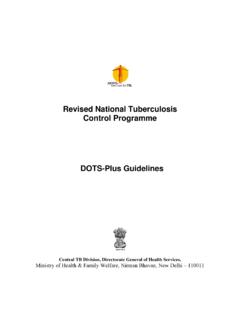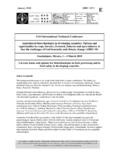Transcription of Contents
1 Health Systems Profile- Lebanon Regional Health Systems Observatory- EMRO Contents 1 EXECUTIVE 2 SOCIO ECONOMIC GEOPOLITICAL Socio-cultural Geography and Political/ Administrative 3 HEALTH STATUS AND Health Status 4 HEALTH SYSTEM Brief History of the Health Care Public Health Care Private Health Care Overall Health Care 5 Process of Policy, Planning and Decentralization: Key characteristics of principal Health Information Health Systems Accountability 6 HEALTH CARE FINANCE AND Health Expenditure Data and Tax-based Out-of-Pocket External Sources of Provider Payment 7 HUMAN Human resources availability and Human resources policy and reforms over last 10 Planned 8 HEALTH SERVICE Service Delivery Data for Health Package of Services for Health Primary Health Non personal Services.
2 Preventive/Promotive Secondary/Tertiary Long-Term 9 HEALTH SYSTEM Summary of Recent and planned 10 Source iHealth Systems Profile- Lebanon Regional Health Systems Observatory- EMRO List of Tables Table 2-1 Socio-cultural Table 2-2 Economic Table 2-3 Major Imports and Table 3-1 Indicators of Health Table 3-2 Indicators of Health status by Table 3-3 Top 10 causes of Morbidity from two Table 3-4 Demographic Table 6-1 Health Table 6-2 Sources of finance.
3 By Table 6-3 MOH Budget as Percent of GOL Table 6-4 Public Health Expenditures of Public Financing Agencies by Table 6-5 Accrual Expenditures of the Ministry of Health between 1999 and Table 6-6 Population coverage by source Table 6-7 Population coverage by source Table 7-1 Health care Table 7-2 Human Resources Training Institutions For Table 8-1 Service Delivery Data and Table 8-2 Inpatient use and ii Health Systems Profile- Lebanon Regional Health Systems Observatory- EMRO FOREWORD Health systems are undergoing rapid change and the requirements for conforming to the new challenges of changing demographics, disease patterns, emerging and re emerging diseases coupled with rising costs of health care delivery have forced a comprehensive review of health systems and their functioning.
4 As the countries examine their health systems in greater depth to adjust to new demands, the number and complexities of problems identified increases. Some health systems fail to provide the essential services and some are creaking under the strain of inefficient provision of services. A number of issues including governance in health, financing of health care, human resource imbalances, access and quality of health services, along with the impacts of reforms in other areas of the economies significantly affect the ability of health systems to deliver.
5 Decision-makers at all levels need to appraise the variation in health system performance, identify factors that influence it and articulate policies that will achieve better results in a variety of settings. Meaningful, comparable information on health system performance, and on key factors that explain performance variation, can strengthen the scientific foundations of health policy at international and national levels. Comparison of performance across countries and over time can provide important insights into policies that improve performance and those that do not.
6 The WHO regional office for Eastern Mediterranean has taken an initiative to develop a Regional Health Systems Observatory, whose main purpose is to contribute to the improvement of health system performance and outcomes in the countries of the EM region, in terms of better health, fair financing and responsiveness of health systems. This will be achieved through the following closely inter-related functions: (i) Descripive function that provides for an easily accessible database, that is constantly updated; (ii) Analytical function that draws lessons from success and failures and that can assist policy makers in the formulation of strategies; (iii) Prescriptive function that brings forward recommendations to policy makers; (iv) Monitoring funcion that focuses on aspects that can be improved.
7 And (v) Capacity building function that aims to develop partnerships and share knowledge across the region. ttOne of the principal instruments for achieving the above objective is the development of health system profile of each of the member states. The EMRO Health Systems Profiles are country-based reports that provide a description and analysis of the health system and of reform initiatives in the respective countries. The profiles seek to provide comparative information to support policy-makers and analysts in the development of health systems in EMR.
8 The profiles can be used to learn about various approaches to the organization, financing and delivery of health services; describe the process, content , and implementation of health care reform programs; highlight challenges and areas that require more in-depth analysis; and provide a tool for the dissemination of information on health systems and the exchange of experiences of reform strategies between policy-makers and analysts in different countries. These profiles have been produced by country public health experts in collaboration with the Division of Health Systems & Services Development, WHO, EMRO based on standardized templates, comprehensive guidelines and a glossary of terms developed to help compile the profiles.
9 A real challenge in the development of these health system profiles has been the wide variation in the availability of data on all aspects of health systems. The profiles are based on the most authentic sources of information available, which have been cited for ease of reference. For maintaining consistency and comparability in the sources of 1 Health Systems Profile- Lebanon Regional Health Systems Observatory- EMRO information, efforts have been made to use as a first source, the information published and available from a national source such as Ministries of Health, Finance, Labor, Welfare; National Statistics Organizations or reports of national surveys.
10 In case information is not available from these sources then unpublished information from official sources or information published in unofficial sources are used. As a last resort, country-specific information published by international agencies and research papers published in international and local journals are used. Since health systems are dynamic and ever changing, any additional information is welcome, which after proper verification, can be put up on the website of the Regional Observatory as this is an ongoing initiative and these profiles will be updated on regular intervals.















